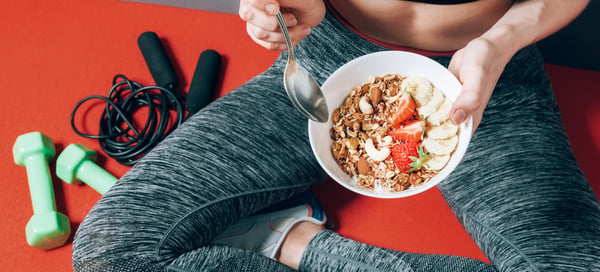Want to lose weight? What’s more important, diet or exercise?

Looking to lose some weight? Should you start exercising or should you change your diet? Can you change the number on the scale with just one or the other or do you have to do both?
I’ve heard from individuals who have lost weight by altering their nutrition and not working out at all.
I’ve also met with people who after starting exercising, slimmed down without changing their eating habits.
I even have spoken with some individuals who made changes to both their diet and exercise routine and didn’t lose anything.
So what should you do?
Weight Loss Basics
Let’s start by reviewing the basics of weight loss. To lose weight you must have a calorie deficit, that is you must be burning more calories each day than you are taking in with food and beverages.
Of course, this simple equation can become very complicated with issues like insulin resistance, unbalanced hormones, lack of sleep and other medical conditions. We won’t get into those situations here.
If you feel you have any medical conditions inhibiting your weight loss, please contact your doctor. However, even without medical reasons making weight loss even more difficult, while a simple equation, creating a calorie deficit and losing weight isn’t easy to do! But it is possible with patience and dedication.
How do you know how many calories you need each day? Your body needs a certain number of calories to maintain your normal bodily functions. That number is your resting metabolic rate (RMR) and it is different for everyone.
There are online calculators to determine your RMR or you can use an app like My Fitness Pal to figure it out for you. The calculator or app will ask you about your activity level.
Your RMR will be multiplied by your activity level; sedentary, lightly active, moderately active or very active. That will give you the number of calories you should be taking in each day.
Subtract 500 calories from that number to give you an updated number of daily calories to put you on track to lose a pound a week.
Studies show it takes a 3,500 calorie deficit in a week to lose a pound, which breaks down to 500 calories a day.
When you have your number of calories to take in each day, keep track of your food and drink intake for at least a few days to ensure you are staying near to your goal. There are many free apps on the market that can help you track your food and can also add in your physical activity.
The calories you burn exercising can be added back to the number of calories you can take in that day and still be on track to lose.
For example, say I should be taking in 1,500 calories daily to lose around a pound a week.
If I run for 30 minutes and burn 200 calories (calorie burn is different for everyone and depends on your height, weight, age, gender and exertion level) then I could eat 1,700 calories that day and still be within my goal for the day.
By making any necessary changes to your nutrition, as well as ensuring you are exercising, you will achieve weight loss faster and in a healthier way. Plus you will be healthier overall!
Here are 5 tips to maximize both diet and exercise for fat loss.
1. HIIT and FIIT
These are important acronyms when it comes to ensuring you are getting the biggest calorie burn from your workouts. HIIT, High Intensity Interval Training, will burn more calories than steady state cardio (like running or walking at the same pace for a period of time).
Plus, with HIIT workouts, your body continues to burn calories hours after your workout as it recovers. This is called excess post-exercise oxygen consumption or EPOC.
EPOC can elevate your RMR up to 38 hours after very high intensity exercise. This number of EPOC boost varies based on the intensity of your workout, your genetics, current fitness level and muscle mass.
Your body will get used to any stimulus you provide it with so what was very difficult a few months ago seems easier now and requires less calories to do. That’s where FIIT comes in.
FIIT stands for frequency, intensity, time and type. By changing either how often you exercise or the number of sets you preform, the intensity of your workout, how long you complete your exercises or how often you work out or the type of your workout, your body will be challenged in a new way and will burn more calories than it would have with your prior workout it was used to.
For example, if you usually do the same five exercises with dumbbells three sets of twelve repetitions, switch to machines that work the same muscle groups or change it to four sets of ten reps with dumbbells.
Change it up! Try a new class, get out your bike, do something different to move your body.
2. Use Weights
More muscle means more calories burned. A pound of muscle burns six calories per day, versus a pound of fat burns which only two calories per day. This increases your RMR and metabolism, which means you will be burning more calories every day even while at rest. A pound of muscle also takes up considerably less space than a pound of fat, so it is not only healthier and burning more calories, it is making you look leaner too.
If you are new to strength training, take a look at our exercise library for instructional videos and instructions.
3. Prioritize Clean Eating
Limit added sugar, focus on lean protein, healthy fats and whole carbs from fruits, vegetables and whole grains.
All calories are not created equal. If you are eating processed foods and other foods with mainly sugar, saturated fats and salt, you will develop consistent cravings and never feel satisfied.
Processed carbs like white flour and foods that are high in sugar or artificial sweeteners will cause your blood sugar to rise sharply but then will crash leaving you hungry again and craving more in an hour or two.
You will feel more satisfied when you are eating lots of foods rich in fiber like legumes (dried beans, lentils), veggies (Brussels sprouts, broccoli, spinach squash, sweet potatoes) and fruit (apples, berries, oranges, pears).
Fiber helps improve blood sugar control, helps lower cholesterol and reduces your risk of chronic diseases like diabetes, colorectal cancer and heart disease as well as keeping you feeling full longer.
Replace processed carbs like white bread, bagels, muffins or donuts for breakfast with high-protein foods like eggs, or Greek yogurt mixed with chia seeds and berries.
For lunch and dinner focus on lean proteins like fish, chicken, turkey, beans, lentils and veggies.
There are many diet trends out there that are not always sustainable and some are not healthy. No gimmicks are necessary if you are eating a well-balanced diet that is within your calorie limits and prioritizes lean proteins, vegetables and whole grains.
If you have questions about a certain diet plan or way of eating, please contact your doctor or a registered dietitian.
4. Watch Liquid Calories
Alcohol, Juice, Coffee Drinks (not just black coffee) can be huge calorie bombs and provide no nutritional value. For example, a Grande Mocha Frappuccino is 410 calories. Imagine your calorie goal for the day is 1,500.
That Frappuccino is over a quarter of your daily intake and doesn’t provide you with much nutritional value. Plus it will probably leave you with a sugar crash in an hour and wanting more. Stick with water, black coffee or unsweetened tea.
5. Make Sure You Are Eating Enough
If you want to lose weight, you may think you need to eat less. Which might be true, but make sure you are eating enough and not starving yourself. Literally.
Extreme calorie restriction can result in amino acids/proteins being used for energy (instead of carbs or fat), meaning muscle loss instead of building lean muscle during a workout.
This would actually reduce your RMR. In other words, slow your metabolism. In general, no one should be consuming less than 1,200 calories per day.
Making sure your nutrition is where it should be is very important to weight loss as well as your overall health. Exercise has many benefits beyond weight loss, but also assists in weight loss by adding to your calorie expenditure.
The key to successful weight loss is a commitment to making lifelong healthy changes in both your diet and exercise habits.
Want a partner in your weight loss journey or don’t know where to start? Schedule a complimentary fitness assessment with a LivRite Personal Trainer to discuss how they can put a plan together for you and work with you to reach your goals!
Topics: LivRite News


